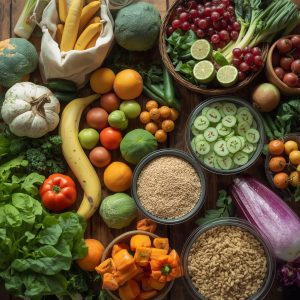Table of Contents
ToggleSustainable Food Choices
In today’s rapidly changing world, making sustainable food choices is no longer just an ethical preference—it is a critical step toward preserving our planet’s future. As consumers become more aware of the environmental consequences of their eating habits, many are turning toward sustainable food systems that prioritize ecological balance, health, and social equity.

The term sustainable food choices refers to selecting foods that have a lower environmental impact, support local economies, and promote overall well-being. This movement encourages mindful consumption, where people consider not just what they eat, but where it comes from and how it was produced. From reducing meat consumption to choosing seasonal produce, these choices can have a profound impact on carbon emissions, water conservation, and biodiversity protection.
The Meaning and Need for Sustainable Food Choices
To truly understand sustainable food choices, one must first examine the unsustainable practices that have dominated the food industry for decades. Industrial agriculture, which relies heavily on chemical fertilizers, pesticides, and intensive livestock production, contributes significantly to greenhouse gas emissions and soil degradation. Food waste and long-distance transportation further add to the problem. Making eco-friendly eating decisions means shifting toward food that minimizes environmental harm and supports long-term food security.
Modern consumers are also becoming conscious of organic agriculture practices, which reduce reliance on synthetic inputs and promote soil health. Buying from local farmers’ markets or participating in community-supported agriculture (CSA) programs are practical ways to implement sustainable eating. These actions shorten the food supply chain, reducing emissions from transport and storage. Additionally, when people invest in local food systems, they contribute to their communities’ economic resilience while supporting farmers who implement environmentally sound techniques.

The Connection Between Sustainable Food and Climate Impact
Every meal we eat has a climate footprint, and plant-based diets are consistently proven to reduce greenhouse gas emissions. Choosing more vegetables, fruits, legumes, and grains over meat and dairy can dramatically lower an individual’s environmental impact. These sustainable meal choices require fewer natural resources like land and water, and they generate fewer emissions during production. This doesn’t necessarily mean eliminating all animal products, but rather reducing consumption and opting for responsibly sourced meats when possible.
Another critical factor in this discussion is food transportation, often referred to as “food miles.” Foods imported from distant regions consume vast amounts of fuel for shipping, which increases carbon emissions. Choosing local and seasonal foods minimizes these impacts while ensuring freshness and nutritional value. Moreover, sustainable farming methods such as crop rotation, regenerative agriculture, and agroforestry further help sequester carbon and rebuild soil fertility, creating a self-sustaining food cycle that benefits both humans and nature.
Water usage also plays a significant role in this equation. For instance, it takes over 1,800 gallons of water to produce one pound of beef, compared to only about 200 gallons for the same weight of beans. By choosing foods with lower water footprints, individuals can make more environmentally responsible diet decisions and help conserve one of our most precious resources.
Ethical and Health Dimensions of Sustainable Food Choices
Beyond environmental impact, sustainable food choices carry profound ethical and health implications. Factory farming often raises concerns about animal welfare, antibiotic overuse, and worker exploitation. Opting for free-range, grass-fed, or certified humane products supports businesses that prioritize ethical treatment of animals and employees. These choices align with broader movements promoting transparency and fairness in the global food system.
On the health front, sustainable diets are closely linked with better nutrition and disease prevention. Diets rich in whole grains, fruits, vegetables, and plant proteins are associated with reduced risks of heart disease, diabetes, and obesity. When people focus on nutritionally sustainable eating habits, they not only protect the environment but also improve their physical well-being. The reduced dependence on processed foods and refined sugars fosters a more balanced lifestyle that promotes longevity.
Moreover, the global pandemic has heightened awareness of the fragility of food systems and supply chains. Many people realized the importance of local food networks and home gardening as a source of security and resilience. The rise of urban farming and community gardens demonstrates how sustainable food choices can also foster social connection and self-reliance, creating a more robust food culture that values quality over quantity.
Practical Ways to Make Sustainable Food Choices
Understanding theory is one thing, but implementing sustainable food choices in daily life requires conscious effort and planning. One effective approach is practicing mindful consumption, where individuals buy only what they need to reduce waste. Globally, nearly one-third of all food produced goes to waste, resulting in massive resource losses and unnecessary emissions. Planning meals, storing food properly, and repurposing leftovers can dramatically cut down on this problem.
Another strategy involves supporting sustainable agriculture initiatives that promote biodiversity and soil regeneration. Consumers can seek certifications like Fair Trade, Rainforest Alliance, or USDA Organic when shopping, ensuring their purchases contribute to environmentally sound practices. Additionally, switching to plant-forward meal planning—where vegetables take center stage and meat becomes a side option—can help reduce dependence on resource-intensive foods without sacrificing taste or satisfaction.

Cooking at home is another powerful act of sustainability. It allows individuals to control ingredient sources, portion sizes, and waste. Using reusable containers, cloth shopping bags, and composting organic waste also helps minimize environmental impact. Even small changes, such as choosing tap water over bottled water or purchasing in bulk to avoid packaging waste, contribute meaningfully to the planet’s health.
Finally, engaging in sustainable seafood consumption by choosing species that are abundant and responsibly fished ensures ocean ecosystems remain balanced. Overfishing is a major ecological concern, but informed consumers can help shift demand toward sustainable fisheries, supporting marine conservation efforts worldwide.
The Future of Sustainable Eating and Global Responsibility
Looking ahead, sustainable food choices are central to achieving the United Nations’ Sustainable Development Goals (SDGs), particularly those focused on climate action, zero hunger, and responsible consumption. The global population is projected to exceed nine billion by 2050, making food sustainability a top priority for future generations. Technological innovations such as vertical farming, lab-grown meat, and precision agriculture will likely transform how food is produced and consumed.
However, technology alone cannot solve the sustainability crisis. A true transformation requires a collective shift in mindset—where consumers, producers, and policymakers work together to promote environmentally and socially just food systems. Governments must incentivize regenerative farming practices, support small farmers, and discourage unsustainable industrial methods. Meanwhile, individuals can use their purchasing power to drive demand for green food initiatives, encouraging corporations to adopt more responsible production models.
Education also plays a vital role. Teaching children about the importance of sustainable eating from an early age fosters lifelong habits that benefit both personal health and the environment. Schools, workplaces, and community centers can host programs and workshops that demonstrate how sustainable food systems work and why they matter.
Ultimately, making sustainable food choices is about more than changing what’s on your plate—it’s about reimagining our entire relationship with food. It’s about respecting the land that nourishes us, supporting those who cultivate it responsibly, and ensuring that future generations inherit a world capable of feeding everyone equitably. Every bite we take can either contribute to the problem or become part of the solution. By choosing wisely, we can all play a vital role in shaping a healthier planet and a more sustainable future.

conclusion
In conclusion, sustainable food choices represent the intersection of ethics, health, and environmental stewardship. They encourage us to think critically about the origins of our meals and their broader consequences. Through conscious effort—buying locally, reducing waste, eating plant-forward meals, and supporting sustainable producers—we can reduce our ecological footprint and build a food system that sustains life rather than depleting it. The journey toward a more sustainable world begins with each decision we make at the dinner table, and by prioritizing these values, we pave the way for a future that nourishes both people and the planet.
